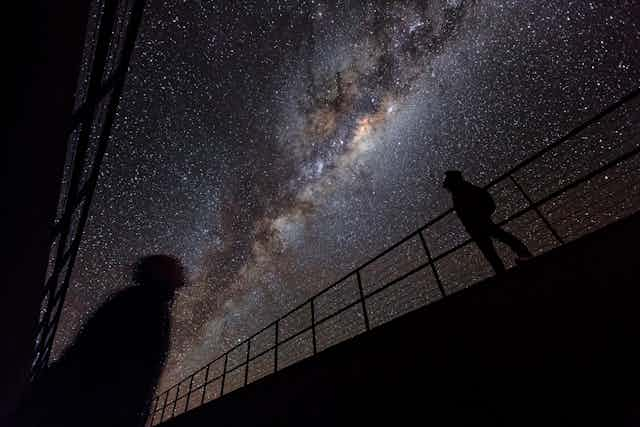When we think of cosmology, we often imagine the largest telescopes peering into the deepest space, collecting the feeble light from exploding stars or the first galaxies.
But for some cosmologists – like the Galactic Archaeologists – the focus is the local universe, asking if we can learn about the evolution of our own Milky Way from what we see around us.
While this local universe is, well, local, how little we know about it can come as quite a surprise; we simply haven’t scanned the immensity of the entire sky in enough detail to reveal its secrets. But new surveys with new telescopes are opening up the sky, and what they are revealing is quite surprising.
Our new cosmic friends
So, what have they discovered?
Two new papers appeared just this month – one from a team based in the US and another by an independent group in the UK – announcing the discovery of new “dwarfs” of the southern sky, small galaxies with only a few hundreds of millions of stars. (Our Milky Way is thought to have several hundred billion stars.)
In fact, both papers presented the discovery of the same eight dwarf galaxies, with the British team identifying potentially one more.

How did two disparate teams identify the same galaxies at the same time? And just what do these observations tells us about the universe? It’s an interesting tale!
Thinking theoretically
Let’s start with the formation and evolution of galaxies.
Over the past 30 years, with the explosive growth of computing power, our cosmological understanding has been revolutionised with synthetic universes revealing how galaxies are born from the featureless cosmic soup of the Big Bang.
Unlike the real universe, through our universe-within-a-computer we can accurately track the motions of mass, watching both dark matter and gas flow together, building galaxies over cosmic time. In these synthetic universes, we would expect the Milky Way to be surrounded by many thousands of smaller dwarfs.
If the Milky Way is really accompanied by such a wealth of smaller galaxies, it would be strong evidence that our ideas of galaxy evolution are pointing in the right direction. So, are they there?
The sky’s the limit
The problem with finding dwarfs is that there is a lot of sky to look at. Dedicated survey telescopes with specialised optics are required.
Over the last few decades, the Sloan Digital Sky Survey (SDSS) has patiently imaged a huge swath of the northern sky, finding many millions of distant galaxies.
But Sloan also yielded many more dwarf galaxies in our own backyard, some reasonably large, with billions of stars, as well as some so puny, with a thousand stars or so, that it is difficult to know whether it is really a galaxy or just an errant bunch of stars.
And are the huge numbers of dwarf galaxies predicted by our model universe within a computer actually there? The simple answer is: no!
Instead of many thousands, SDSS saw only a handful. This missing satellites problem has significant implications for our understanding of galaxy evolution. But to know just how bad the problem is, we need to know just how missing the dwarfs really are!
While a spectacular success, SDSS, based in the US, has only stared at the northern sky. Before we can fully answer the question, we need a complete census. We need to survey the southern sky!
There is a steadily growing army of survey telescopes in the south, including VISTA in Chile and SkyMapper here in Australia. But, at the moment, out in the lead is a survey that is not focused on local universe at all.
The Dark Energy Survey
The discovery of dark energy has revolutionised our view of cosmology, revealing that the expansion of the universe is accelerating. But the fact that we don’t really know what dark energy is means it remains one of the biggest astrophysical mysteries.
Astronomers have planned new observational approaches to uncover the secrets of dark energy. Currently, a new camera, DECam, on the Blanco 4m Telescope in Chile is on the case.
Its goal is the Dark Energy Survey (DES), a search for the subtle influence of dark energy on our observations of the distant universe. To do this, DECam will survey a huge swath of the southern sky.
Collateral science
As DECam stares into the distant universe, it also captures all the things in between, so its data will be a goldmine for a broad range of science. Within the DES collaboration are astronomers primed to reap the scientific rewards on offer.
So why two papers on the same objects at the same time? As DECam collects data, chunks are periodically given away to the entire astronomical community, allowing as much science as possible to be squeezed from the observations.
Astronomers outside the DES collaboration are equally hungry to search for DECam dwarf galaxies. The act of sharing data does maximise the science, but even the astronomers taking the data cannot hang around as there is a good chance they will be scooped.

What did we learn?
The discovery of these new dwarfs does not solve the missing satellite problem, but is providing clues to bridge our gap between the observed and theoretical universe.
The clustering of these dwarfs around the Magellanic Clouds may point towards all of these galaxies having fallen together into the Milky Way as a small group. If this really is the accretion of a group, it opens an exciting window onto galaxy evolution.
But it’s important to remember that these new galaxies were found in the first year’s worth of data from DECam, with more data becoming available on a yearly basis.
With more and more sensitive eyes pointing at the sky, we can expect many more dwarfs of the southern sky to be revealed.

